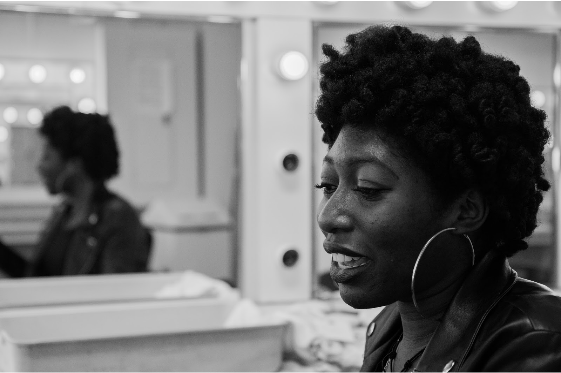“For Colored Girls Who Have Considered Suicide When The Rainbow Is Enuf” tells the story of seven women of color who find unity through the shared oppression of a racist and sexist society to form a sisterhood through stories of love, empowerment, struggle and loss. The play will be performed by the SUNY New Paltz theater department between February 28 and March 10, 2019 at McKenna Theater.
All stories edited and packaged by Katie Donlevy and Brandi Sutfin.
Ifeoma Ukatu, born and raised in Staten Island, NY, is a junior at SUNY New Paltz majoring in theatre. Ifeoma comes from a musical background and plays the saxophone, piano and guitar. She’s been singing and dancing since she was a little girl, and will be portraying the Lady in Orange in the upcoming play For Colored Girls Who Have Considered Suicide When The Rainbow is Enuf.
Q: Is this the first play you’ve been cast in here at SUNY New Paltz?
A: No, but this is my first main stage production; we have different series here within our theater department. The first play I did was in my sophomore year. At the time, I was a biology and computer science major before I switched to theater.
“…Dance: it’s the beat that keeps her going. It’s her lifeline, statement and savior.”
Q: What compelled you to perform For Colored Girls?
A: As soon as I learned that we would do For Colored Girls, I was so excited because this is the first time that I saw a play depicting what it is like to be a woman of color, and a black woman specifically. We don’t really get to showcase a lot of things that are for us or about us, us being people of color.
Q: Tell us about your character, Lady in Orange.
A: Lady in Orange is really a mix of the Ladies in Red and Yellow. Lady in Red has that passion and fiery persona, while Lady in Yellow is more cheerful, bright and optimistic. Lady in Orange combines those components of those other ladies. She’s our movement character. She’s into dance; it’s the beat that keeps her going. It’s her lifeline, statement and savior, which is why she doesn’t like to speak much. She likes to dance her words out, but definitely speaks when she has something to say. When it comes to her pain, the rawness of her emotion transits against you.
Q: Are you anything like your character Lady in Orange?
A: Oh, definitely. I’m so much like Lady in Orange. It’s actually funny how much I tend to find that out more as I rehearse. I love dancing even when I’m not in rehearsal. It’s an escape for me, it’s a way for me to check in on myself, and transform my energy. So I think that’s something that we have in common.
Q: How does the play represent struggles that the average African American woman faces?
A: I think all of the characters represent black women. What is the “average black woman?” I don’t really think there is an average black woman because we come in all shapes and sizes. We come from all walks of life, we come in all beliefs, we come in interest. We are our own because we are so multifaceted. Yes, you get a glimpse through seven women into different kinds of black women, they are threads that link us together. But there’s no such thing as the average black woman because we have too much in common.
Q: What can we expect to see when you perform Lady in Orange in this play?
A: Well, I think it depends on my audience, because the majority of people are not going to know me. As for Lady in Orange it’s important that I let her energy out, because this is her life. I will push through, hitting everything hard and letting raw emotion out. They won’t know Ifeoma, but they’ll be able to see the truth of Lady in Orange because that’s what matters the most.
Read more #ForColoredGirls features here:
Lani Volino pulls the strings and leads the show as she tries her hand as the Stage Production Manager
Stefanie Workman plays the Lady in Brown, but is also responsible for elevating the magic and power of the show through her skills as a hair and makeup artist.
Tatiana Saintilus plays the Lady in Yellow, the brightest personality of the show and a character that required delving into the mind of to understand her naivety.
Ifeoma Ukatu appears as the Lady in Orange, a character that embodies Ntozake Shange’s creation of choreopoetry: dramatic expression that combines song, dance, poetry and music.
Deborah Crumbie plays the Lady in Red, a character she was able to identify with after finding parallels between herself and the onstage persona.
Clarissa Mota is the brains of the operation: the dramaturg. Mota is responsible for knowing background information, research and various knowledge of the show to assist all crew members put on an accurate production
Emily Kimoto serves as the Assistant Stage Manager, assisting in backstage management to help run the show as smoothly as possible.
